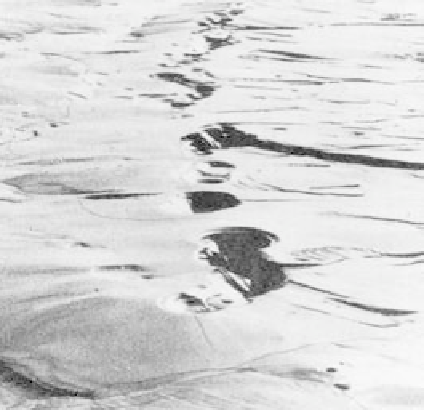Geoscience Reference
In-Depth Information
with that for the 1D flow of heat through solid media
(Section 4.18, Cookie 19). Like the heat conduction
equation, it is an easy matter to solve the expression for
equilibrium flow once
K
, a constant for a given arrange-
ment of porosity, pore shape, pore size, fluid density, and
fluid viscosity, is known. The
Kozeny-Carman equation
(not developed here) offers an approximate analytical solu-
tion to determining
K
as a function of these variables as
long as the particle packing is random and natural homog-
enous isotropic porosity occurs.
height from ten to fifteen feet, and in a black shower,
mixed with sand . . . The whole surface of the country
remained covered with holes, which resembled so many
craters of volcanoes.” There is also widespread evidence
for the sinking of buildings and other structures into sands
during earthquakes, recalling the Biblical adage that pre-
dates modern building regulations by some millennia.
Although earthquakes undoubtedly impose an effective
trigger mechanism for liquefaction, they are by no means
the only one. Thus eruption of sediment and water com-
monly occurs during river floods from the bases of artificial
and natural levees.
What processes lead to production of a liquid-like state
from what was previously a stable mass of water-saturated
sand? There are two ways in which such a transformation
can take place:
1
Upward displacement of fluid may be sufficient in itself to
cause overlying grains to remain in suspension by
fluidization
or
seepage liquefaction
, conveniently defined as the process
whereby a granular aggregate is converted to a fluid by flow
through it. The fluidized suspension may be en masse or just
restricted to selected pipe-like conduits as in the New Madrid
earthquake. Fluidization in its most simple sense requires the
velocity of moving pore fluid,
U
f
, to exceed the grain fall
velocity,
U
p
. More generally, in order for en masse fluidization
to occur, the upward-moving fluid must exert a normal stress
f
equal to or greater than the immersed weight of any over-
lying sediment. This force is given by
4.13.2 Liquefaction and fluidization of granular
aggregates
We now turn to the case when the particles in saturated
granular aggregates (Section 4.11) are simply resting upon
one another under gravity, with no cementing medium
holding them together. It is possible to imagine the situa-
tion where throughflow might cause motion of the parti-
cles away from each other: the grain aggregate is then in a
state of
liquefaction
. For example, it is a common observa-
tion after large earthquakes that sand and water mixtures
are expelled (often violently) from the shallow subsurface
in fountains to form sand volcanoes (Fig. 4.69). Here are
the observations made by an anonymous observer of the
great New Madrid earthquake of 1811-12 in the lower
Mississippi Valley: “Great amounts of liquid spurted into
the air, it rushed out in all quarters . . . ejected to the
is effective (immersed) grain density,
g
is gravity,
h
is overlying
f
g
Ch
, where
(a)
Schematic of the simple
condition for fluidization
p
1
(b)
Particle
fall
velocity,
U
Fluid
velocity,
U
p
f
Fluidized aggregate ( U
p
< U
f
)
Initial condition
Fig. 4.69
(a) Sand volcanoes formed in a field after liquefaction induced by an earthquake, Imperial valley, California; (b) experimental
fluidization and sudden conduit escape as a sand volcano eruption produced by water flow through a lower, more permeable, granular
bed underlying an upper less permeable bed (dark layer).










Search WWH ::

Custom Search